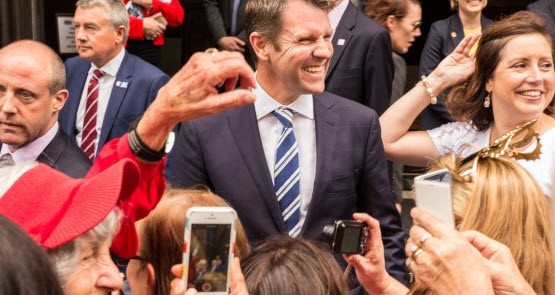
NSW Premier Mike Baird’s reputation as the nation’s foremost “Teflon” politician just keeps advancing. Nothing sticks to this ever-smiling Liberal who evades bouncers with the agility of a first-class opening batsman.
Is it luck or shrewd management? That’s still not clear, but Baird is unconcerned: he is counting the poll numbers, which are growing faster for him than any other state leader.
Selling the first tranche of the state’s “poles and wires” for a bumper $10 billion has boosted Treasury’s bottom line and cast the Labor opposition into the doldrums.
Before, during and after the March state election, Baird’s critics savaged him for claiming the long leasing of three electricity networks would raise $20 billion for infrastructure projects.
Here are the numbers he promised: $13 billion from poles and wires leasing, $2 billion from the Commonwealth and $5 billion from interest, giving a grand total of $20 billion.
Labor’s central election theme of anti-privatisation accused him of exaggerating: he would never be able to raise that kind of money; he was conning the voters; electricity prices would go through the roof; and he was telling fibs.
During the election campaign Labor spin doctors said Baird would struggle to raise $5 billion for TransGrid, and they derided his transport building program.
However, with this week’s 99-year lease of TransGrid to an international consortium headed by Australian-owned Hastings Funds Management and Spark Infrastructure, Baird is on track to raise the $20 billion he promised.
He’s about to bank $10 billion from the lease deal with the Kuwaiti-backed consortium and then raise a few more billion from the lease of 50.4% of two other public networks, Ausgrid and Endeavour Energy.
On top the “poles and wires” bonanza, NSW Treasury is already swamped with billions of dollars from residential stamp duty raised during Sydney’s property “bubble”. In 2014-15 the stamp duty windfall reached $5 billion, and Treasury expects to raise another $4 billion in the current financial year.
This means the Coalition will pay for its long list of expensive infrastructure projects, including the Sydney Metro, a new rail link running from Chatswood on the North Shore, through the CBD to Bankstown in the city’s south west.
Baird faced the TV cameras this week saying: “This [TransGrid] result is a stunning result for the people of NSW. It means there is, for the people of NSW, better transport, roads, schools and hospitals.”
Opposition Leader Luke Foley made a confusing comment that the money would not meet the $6.8 billion blow-out on costs for the WestConnex motorway, while the Greens hid away after their prolonged scare campaign simply fizzled out.
Bur Treasury sources told Crikey Baird’s bulging treasure chest will cover any WestConnex over-runs and they guarantee completion of the 35-kilometre project by 2024.
Labor and the Greens are lucky that Parliament rose a fortnight ago, otherwise they would have subjected to the ordeal of Liberal crowing about the state’s triple A credit rating and four consecutive budget surpluses.
Foley’s shadow cabinet appears to have no answer to Baird’s swarming popularity. It is starting to dawn on them that they aren’t facing a two-term Coalition government (Barry O’Farrell in 2011 and Baird in 2015) but a three or even four-term administration.
And for ALP leaders who pride themselves on belonging to “the natural party of government” in NSW that’s proving very hard to take.








The usual suspects must be agonising over the trauma of seeing a Coalition Premier doing the correct thing and they’ve failed miserably to misrepresent the true economic situation.
Has Crikey considered establishing a fund to counsel its many distraught subscribers?
So, with a purchase of $10B, they need to make a profit of over $2M per week before mundane stuff like maintenance.
Could this be a new version of asset stripping, aka bottom of the harbour? Gouge as much profit with as little expense as possible then cede control when it all begins to fall apart?
Could be AR. What concerns me with teflon Mike, is the collection of blond airhead Nationals like Troy Grant.Grant is a worthless MP who at a local level has been incredible lazy and lacklustre. where is their representation of their people in this. What is more, we will eventually get the power price upsurge, but we get NOTHING in terms of infrastructure. Our roads are garbage, there is still no decent road to Sydney 200 years after Cox. The railways are stuffed, the passenger rail tracks are a joke. The Newcastle Flyer in 1938 was probably faster than an intercity express due to the tracks. We do not live in NSW apparently. Alas we are west of Penrith.
Hunter people are not infatuated with Baird like the rest of you. See the ugly and devious process of Newcastle rail termination; or the Rio Tinto co-option of Baird & Co in an apalling breach of contract with residents at the Bulga/ Mt Thorley coalface..
The Hunter lies only 150 – 200 km north of the state capital but gets zero national media coverage, not being part of Sydney unless it suits them. Then we are called Greater Metropolitan, ha-ha. It is the worst of both worlds.
In spite of all the political crap we have a pretty wonderful lifestyle in Newcastle/ Lake Macquarie etc. It’s just zero morale for political tragics, i.e. anyone who gives a monkeys.
Might be interesting when power bills come in, if they are up heaps anyway.